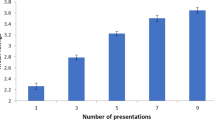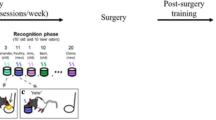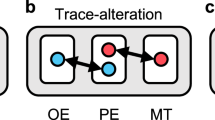Abstract
Memory for past events can be based on recollection or on assessments of familiarity. These two forms of human memory have been studied extensively by philosophers and psychologists, but their neuroanatomical substrates are largely unknown. Here we examined the brain regions that are involved in these two forms of memory by studying patients with damage to different temporal lobe regions. Our results come from (i) structural covariance modeling of recall and recognition, (ii) introspective reports during recognition and (iii) analysis of receiver operating characteristics. In sum, we found that the regions disrupted in mild hypoxia, such as the hippocampus, are centrally involved in conscious recollection, whereas the surrounding temporal lobe supports familiarity-based memory discrimination.
This is a preview of subscription content, access via your institution
Access options
Subscribe to this journal
Receive 12 print issues and online access
$209.00 per year
only $17.42 per issue
Buy this article
- Purchase on Springer Link
- Instant access to full article PDF
Prices may be subject to local taxes which are calculated during checkout




Similar content being viewed by others
References
Scoville, W.B. & Milner, B.J. Loss of recent memory after bilateral hippocampal lesions. J. Neurol. Neurosurg. Psychiatry 20, 11–21 (1957).
Parkin, A.J. & Leng, R.C. Neuropsychology of the Amnesic Syndrome (Erlbaum, Hillsdale, New Jersey, 1993).
Amaral, D.G. What is where in the medial temporal lobe? Hippocampus 9, 1–6 (1999).
Duvernoy, H.M. The Human Hippocampus: Functional Anatomy, Vascularization and Serial Sections with MRI (Springer, New York, 1998).
Aggleton, J.P. & Brown, M.W. Episodic memory, amnesia, and the hippocampal-anterior thalamic axis. Behav. Brain Sci. 22, 425–489 (1999).
Eichenbaum, H., Otto, T. & Cohen, N.J. The hippocampal system: dissociating its functional components and recombining them in the service of declarative memory. Behav. Brain Sci. 17, 449–776 (1994).
Gabrieli, J.D.E., Brewer, J.B., Desmond, J.E. & Glover, G.H. Separate neural bases of two fundamental memory processes in the human medial temporal lobe. Science, 276, 264–266 (1997).
Henson, R.N.A., Rugg, M.D., Shallice, T., Josephs, O. & Dolan, R.J. Recollection and familiarity in recognition memory: an event-related functional magnetic resonance imaging study. J. Neurosci. 19, 3962–3972 (1999).
Eldridge, L.L., Knowlton, B.J., Furmanski, C.S., Bookheimer, S.Y. & Engel, S.A. Remembering episodes: a selective role for the hippocampus during retrieval. Nat. Neurosci. 3, 1149–1152 (2000).
Yonelinas, A.P., Kroll, N.E.A., Dobbins, I., Lazzara, M.M. & Knight, R.T. Recollection and familiarity deficits in amnesia: convergence of remember/know, process dissociation and receiver operating characteristic data. Neuropsychology 12, 323–339 (1998).
Rempel-Clower, N.L., Zola, S.M., Squire, L.R. & Amaral, D.G. Three cases of enduring memory impairment after bilateral damage limited to the hippocampal formation. J. Neurosci. 16, 5233–5255 (1996).
Hopkins, R.O., Kesner, R.P. & Goldstein, M. Item and order recognition memory in subjects with hypoxic brain injury. Brain Cogn. 27, 180–201 (1995).
Gadian, D.G. et al. Developmental amnesia associated with early hypoxic-ischaemic injury. Brain 123, 499–507 (2000).
Zola, S.M. & Squire, L.R. in The Oxford Handbook of Memory (eds. Tulving, E. & Craik, F. I. M.) 485–500 (Oxford Univ. Press, New York, 2000).
Aggleton, J.P. & Shaw, C. Amnesia and recognition memory: a re-analysis of psychometric data. Neuropsychologia 34, 51–62 (1996).
Mandler, G. Recognizing: the judgment of previous occurrence. Psychol. Rev. 87, 252–271 (1980).
Nunally, J.C. & Bernstein, I.H. Psychometric Theory (McGraw-Hill, New York, 1994).
Janowsky, J.S., Shimamura, A.P., Kritchevsky, M. & Squire, L.R. Cognitive impairment following frontal lobe damage and its relevance to human amnesia. Behav. Neurosci. 103, 548–560 (1989).
Jöreskog, K.G. in Contemporary Developments in Mathematical Psychology: Measurement, Psychophysics and Neural Information Processing (eds. Krantz, D. H. et al.) 1–56 (W. H. Freeman, New York, 1974).
Nyberg, L. A structural equation modeling approach to the multiple memory systems question. J. Exp. Psychol. Learn. Mem. Cogn. 20, 485–491 (1994).
Sauve, M.J. et al. Factors associated with cognitive recovery after cardiopulmonary resuscitation. Am. J. Critical Care 5, 127–139 (1996).
Tulving, E. Memory and consciousness. Can. J. Exp. Psychol. 26, 1–12 (1985).
Macmillan, N.A. & Creelman, C.D. Detection Theory: a User's Guide (Cambridge Univ. Press, New York, 1991, p. 407).
Yonelinas, A.P., Hopfinger, J.B., Buonocore, M.H., Kroll, N.E.A. & Baynes, K. Hippocampal, parahippocampal and occipital-temporal contributions to associative and item recognition memory: an fMRI study. Neuroreport 12, 359–363 (2001).
Squire, L.R. & Zola, S.M. Episodic memory, semantic memory and amnesia. Hippocampus 8, 205–211 (1998).
Tulving, E. & Markowitsch, H.J. Episodic and declarative memory: role of the hippocampus. Hippocampus 8, 198–204 (1998).
Mishkin, M., Vargha-Khadem, F. & Gadian, D.G. Amnesia and the organization of the hippocampal system. Hippocampus 8, 212–216 (1998).
Kuwert, T. et al. Post-hypoxic amnesia: regional cerebral glucose consumption measured by positron emission tomography. J. Neurol. Sci. 118, 10–16 (1993).
Schmidt-Kastner, R. & Freund, T.F. Selective vulnerability of the hippocampus in brain ischemia. Neuroscience 40, 599–636 (1991).
Caine, D. & Watson, J.D. Neuropsychological and neuropathological sequelae of cerebral anoxia: a critical review. J. Int. Neuropsychol. Soc. 6, 86–99 (2000).
Markowitsch, H.J., Weber-Luxemburger, G., Ewald, K., Kessler, J. & Heiss, W.D. Patients with heart attacks are not valid models for medial temporal lobe amnesia. A neurological and FDG-PET study with consequences for memory research. Eur. J. Neurol. 4, 178–184 (1997).
Vargha-Khadem, F. et al. Differential effects of early hippocampal pathology on episodic and semantic memory. Science 277, 376–80 (1997).
Hopkins, R.O., Kesner, R.P. & Goldstein, M. Item and order recognition memory in subjects with hypoxic brain injury. Brain Cogn. 27, 180–201 (1995).
Press, G.A., Amaral, D.G. & Squire, L.R. Hippocampal abnormalities in amnesic patients revealed by high-resolution magnetic resonance imaging. Nature 7, 54–57 (1998).
Kartsounis, L.D., Rudge, P. & Stevens, J.M. Bilateral lesions of CA1 and CA2 fields of the hippocampus are sufficient to cause a severe amnesic syndrome in humans. J. Neurol. Neurosurg. Psychiatry 59, 95–98 (1995).
Cummings, J.L., Tomiyasu, U., Read, S. & Benson, D.F. Amnesia with hippocampal lesions after cardiopulmonary arrest. Neurology 34, 679–681 (1984).
Zola-Morgan, S., Squire, L.R. & Amaral, D.G. Human amnesia and the medial temporal region: enduring memory impairment following a bilateral lesion limited to field CA1 of the hippocampus. J. Neurosci. 6, 2950–2967 (1986).
Smith, M.L., Auer, R.N. & Siesjo, B.K. The density and distribution of ischemic brain injury in the rat following 2–10 min of forebrain ischemia. Acta Neuropathol. 64, 319–332 (1984).
Baddeley, A., Vargha-Khadem, F. & Mishkin, M. Preserved recognition in a case of developmental amnesia: implications for the acquisition of semantic memory? J. Cogn. Neurosci. 13, 357–369 (2001).
Düzel, E., Vargha-Khadem, F., Heinze, H.J. & Mishkin, M. Brain activity evidence for recognition without recollection after early hippocampal damage. Proc. Natl. Acad. Sci. USA 98, 8101–8106 (2001).
Schacter, D.L., Chiu, C.Y.P. & Ochsner, K.N. Implicit memory: a selective review. Annu. Rev. Neurosci. 16, 159–182 (1993).
Wagner, A.D., Gabrieli, J.D.E. & Verfaellie, M. Dissociations between familiarity processes in explicit recognition and implicit perceptual memory. J. Exp. Psychol. Learn. Mem. Cogn. 23, 305–323 (1997).
Buckner, R.L. et al. Functional anatomical studies of explicit and implicit memory retrieval tasks. J. Neurosci. 15, 12–29 (1995).
Schacter, D.L., Alpert, N.M., Savage, C.R., Rauch, S.L. & Albert, M.S. Conscious recollection and the human hippocampal formation: evidence from positron emission tomography. Proc. Natl. Acad. Sci. USA 93, 321–325 (1996).
Hamann, S.B. & Squire, L.R. Intact perceptual memory in the absence of conscious memory. Behav. Neurosci. 111, 850–854 (1997).
Rey, A. L'Examen Clinique en Psychologie (Presses Univ. de France, Paris, 1964).
Wechsler, D. The Wechsler Memory Scale-R (Psychological Corp., Harcourt Brace Jovanovich, New York, 1987).
Yonelinas, A.P. & Jacoby, L.L. The relation between remembering and knowing as bases for recognition: effects of size congruency. J. Mem. Lang. 34, 622–643 (1995).
Jennings, J.M. & Jacoby, L.L. Automatic versus intentional uses of memory: aging, attention, and control. Psychol. Aging 8, 283–293 (1993).
Acknowledgements
This work was supported by the National Institutes of Health (grants MH59352, NS21135 and NS40813).
Author information
Authors and Affiliations
Corresponding author
Ethics declarations
Competing interests
The authors declare no competing financial interests.
Rights and permissions
About this article
Cite this article
Yonelinas, A., Kroll, N., Quamme, J. et al. Effects of extensive temporal lobe damage or mild hypoxia on recollection and familiarity. Nat Neurosci 5, 1236–1241 (2002). https://doi.org/10.1038/nn961
Received:
Accepted:
Published:
Issue Date:
DOI: https://doi.org/10.1038/nn961
This article is cited by
-
Towards a dual process epistemology of imagination
Synthese (2021)
-
The role of KIBRA in reconstructive episodic memory
Molecular Medicine (2018)
-
RETRACTED ARTICLE: A study on cognitive impairment and gray matter volume abnormalities in silent cerebral infarction patients
Neuroradiology (2015)
-
Recollection and Familiarity in Aging Individuals with Mild Cognitive Impairment and Alzheimer’s Disease: A Literature Review
Neuropsychology Review (2014)
-
The Effects of Healthy Aging, Amnestic Mild Cognitive Impairment, and Alzheimer’s Disease on Recollection and Familiarity: A Meta-Analytic Review
Neuropsychology Review (2014)



